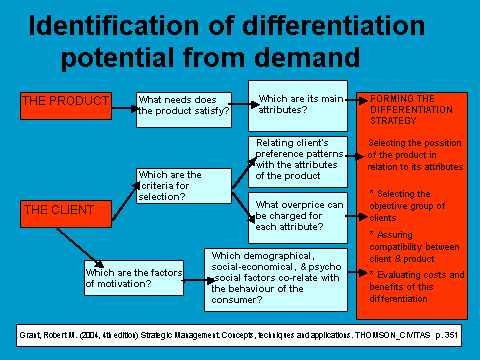Differentiation from demand
At the beginning of this differentiation block, we were saying: the characteristics and needs of the client must be known exhaustively from the point of view of the demand. This is the basic premise, the idea that must be clear, our point of departure.
Once an enterprise knows its clients (tastes and tendencies) perfectly, it can group them together. From this point, it must be capable of offering to each one of these groups products/services that are different from the rest, and for which they would be willing to pay more
Despite the fact that a market investigation reveals the preferences of clients, the base of success for a differentiation strategy is in understanding the client. Simple and direct questions help understand and know why a client purchases a specific product, which needs this product covers, etc. This is the first step: identifying why clients buy a determined product. If the needs the client wants to cover with a product are bound to the attributes given to a product by an enterprise, we would have reached the product our client wants. It would be a product that has a place in our client's mind and is different for him since it satisfies his/her needs completely. We would have achieved a difference in the minds of our clients.
As a second step, and falling into the knowledge of the demand, we could ask a few basic questions, like: Which are the criteria for election? or, What are the motivations at the time of inclining for one product or another? Thus, we will know the preferences of our different clients, resembling his tastes and preferences to make possible a market segmentation to provide a differentiated offer to each one of these segments. With motivations, we could reach demographical and social conclusions; aspects which will be key at the time we launch our differentiated offer. This dynamic will also allow to detect market niches, or in other words, an unsatisfied client demand. At this point, the enterprise has to recognize if it has the capability and resources to satisfy this demand.
We summarize everything in the following chart. The enterprise will formulate its differentiation strategy. This strategy will place its product, select a destination market, assure compatibility (it would be incoherent if not), and finally, evaluate costs and benefits from this differentiation.
